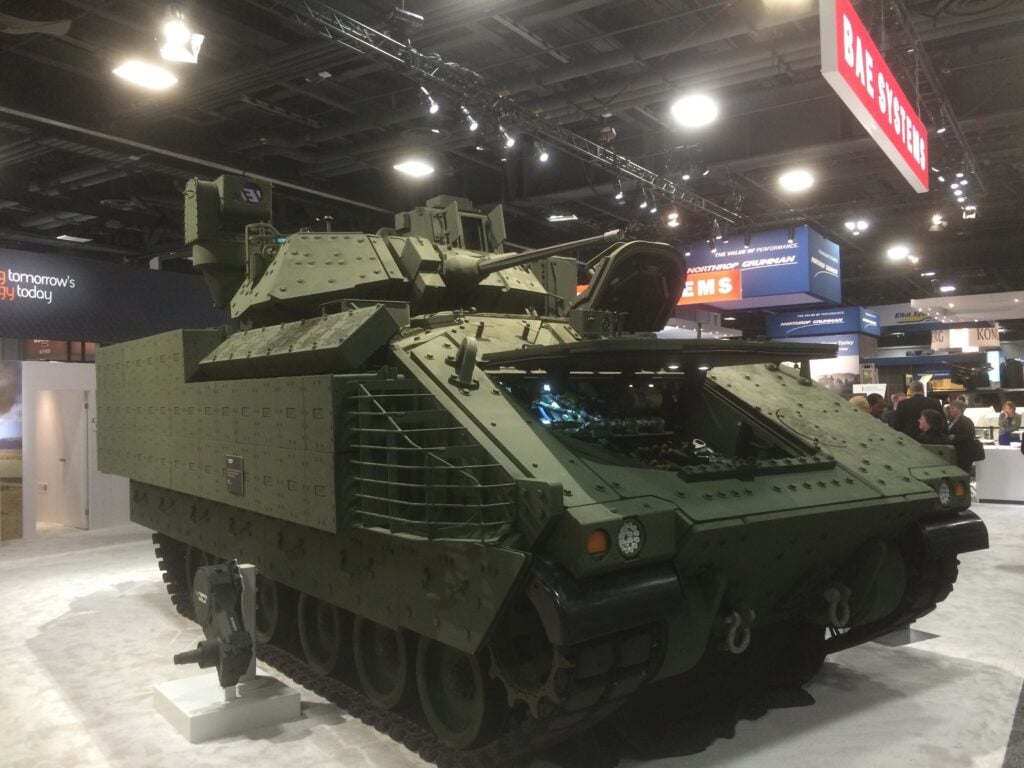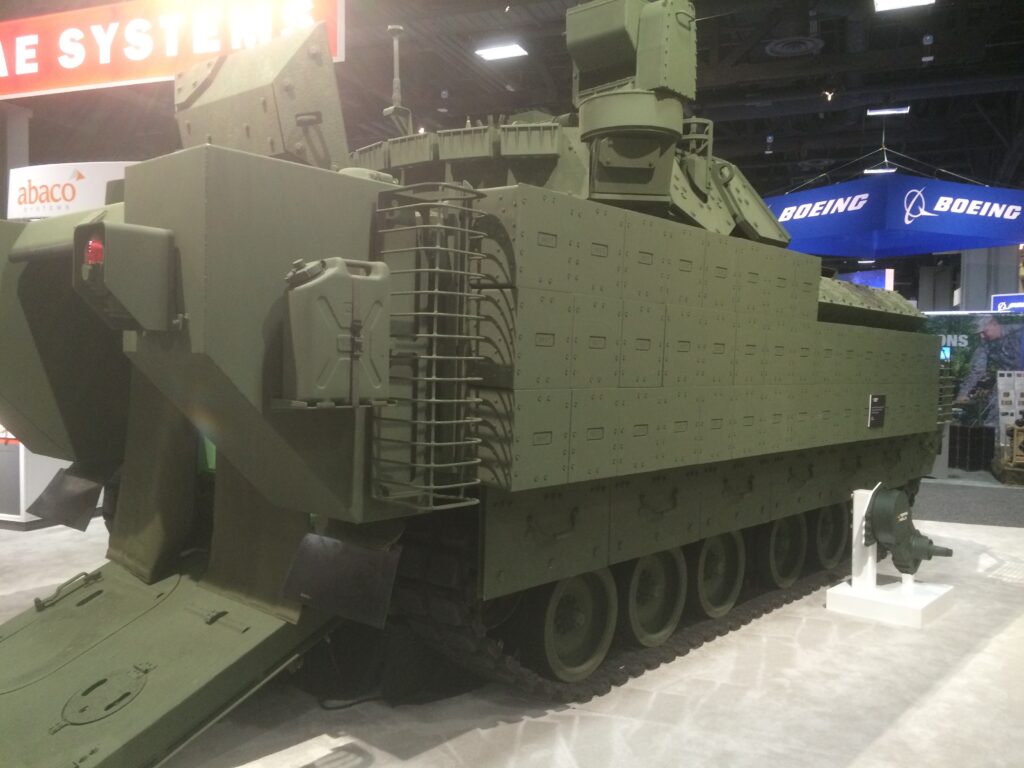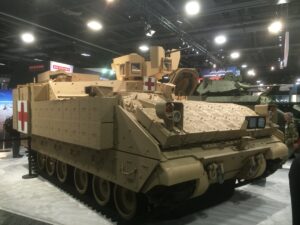
BAE Next Generation Bradley demonstrator at AUSA
WASHINGTON: More horsepower. Higher suspension. A blast-resistant underbody. Safer fuel tanks. A larger hull. Take it all together and this may not just be another upgrade but more like a complete rebuild. The goal is allow the 1980s-vintage M2 Bradley to survive on the battlefields of the 2030s, contractor BAE Systems said. Since there is no money in the budget for an all-new vehicle, the Army is listening.
“I’d love to have replacement programs today for Abrams and Bradley,” said Maj. Gen. David Bassett, the Army’s head of heavy vehicle modernization. “It doesn’t fit in this portfolio and this budget.”
So, just one floor up from the room where Bassett briefed reporters at the annual Association of the US Army conference, BAE showcased its Next-Generation Bradley. The concept vehicle certainly looks like the current Bradley to the untrained eye. The one obvious difference is the armored triangles jutting from the back, which hold the fuel tanks — relocated from inside the hull so a fuel explosion blasts outward, away from the crew. But there are so many other changes that, listening to BAE, I recalled the old parable of Lincoln’s axe. If you replace the handle and replace the blade, what’s left of what you started with?

The back of the Next Generation Bradley, showing the triangular reconfigured fuel tanks.
Plenty, said Deepak Bazaz, BAE’s director of Bradley programs. Most notably, he said, “we didn’t touch the turret.” The Next-Gen Bradley uses the latest-model A4 Bradley turret, complete with its expensive electronics, 25 mm cannon, and TOW anti-tank missiles. (That said, most currently Bradleys aren’t fully upgraded to the A4 standard). Other, less visible components carry over as well. Overall, rebuilding a current Bradley into a Next-Gen one should cost significantly less than buying an entirely new vehicle.
But how can it be the same vehicle when it has an all-new hull? I asked incredulously. Hulls aren’t actually a huge component of vehicle cost, Bazaz replied. They cost about the same as the transmission, and we don’t say we’re getting a new vehicle when we just get the transmission rebuilt.
The new hull is one piece of a ground-up redesign for survivability. The Bradley’s already being upgraded with a higher suspension, which both improves off-road mobility and gives more distance from a mine or roadside bomb. On top of this, the Next-Gen hull is thicker on the bottom and adds seven inches more headroom at the top: Headroom matters not just for comfort but because underbody blasts tend to slam soldiers’ skulls into the ceiling.
Inside the vehicle, the torsion-bar suspension has been redesigned so the bars don’t come loose in an explosion and rip upward through the floor of the troop compartment like oversized shrapnel. That troop-compartment floor is attached only at the sides instead of resting on the hull below it, so the bone-shattering shockwave travels up the walls instead of through the floor and into soldiers’ legs.
The redesign also relocates the fuel tanks — into those projecting triangles I mentioned above — and the spare TOW missiles, so a hit on either won’t cause an explosion in the crew compartment. Overall, BAE claims the upgraded protection against mines and roadside bombs is better than an MRAP, the Mine-Resistant Ambush-Protected vehicles built for Afghanistan and Iraq.
These upgrades do add weight. A typical modern Bradley — itself considerably uparmored over the 1981 original — weighs about 40 tons, Bazzaz said. A Next-Gen Bradley weighs 45 tons, a 12.5 percent increase. But whereas the current Bradleys have no automotive or electrical power to spare, limiting future upgrades, the Next-Gen has a superior engine, transmission, and generator, Bazzaz says, allowing it to grow to 50 tons with no loss in performance.
The extra electrical power is particularly important. Modern sensors, targeting systems and communications take a lot of power. Radio jammers to prevent roadside bombs from detonating take even more. Bradleys in Iraq sometimes experienced brown-outs, forcing them to shut off one system to free up power for another.
Then there’s the next wave in survivability, so-called Active Protection Systems (APS), which use radars to detect incoming rounds and mini-rockets to shoot them down. APS adds a lot of protection, but it draws a lot of power — which the current Bradley doesn’t have to spare. The Army is testing off-the-shelf APS in 2017 and 2018, said Col. Glenn Dean, but it’ll test it on Bradley last because of the vehicle’s limits on available size, weight, and power.

Armored Multi-Purpose Vehicle at AUSA. AMPV pioneered the hull and many other components used for the Next-Generation Bradley.
The Army does have a program to upgrade the Bradley’s electrical power, suspension, engine, and turret, but its current plans don’t include any overhaul as radical as the Next-Gen Bradley. “What BAE has down there right now is basically an example of what you could do if you wanted to do an incremental improvement to the Bradley and incorporate some greater force protection,” said Col. Mike Milner, who manages the Armored Multi-Purpose Vehicle program.
AMPV is essentially an upgraded turretless Bradley — to be used as an armored transport, ambulance, and command post — and it pioneered many of the improvements used on Next-Gen Bradley. “The demonstrator they have down there is pretty much the AMPV hull with the Bradley turret on it, with the new drive train (and) a new transmission on the inside that offers a little better efficiency,” Milner told me.
So could you rebuild existing Bradleys as Next-Gen? “it’s something that could be done,” Milner said. As we go forward and look at the Bradley and where does the Army want to go in terms of its next generation fighting vehicle — does it want to do a clean-sheet design or does it want to do a major modification to the Bradley? — BAE has proposed one solution down there.”
Practically speaking, though, an all-new vehicle — that “clean-sheet design” — is something the Army can’t afford. Having canceled two previous attempts to replace the Bradley, the Future Combat Systems and the Ground Combat Vehicle, the Pentagon has pushed what’s now called the Future Fighting Vehicle out past 2030. Even if FFV materializes on time — and an Army-commissioned RAND study said there wasn’t enough money for it — it won’t be fielded fast enough to replace all the Bradleys until well into the 2040s.
“The way we’re affording all the things we’re affording is by producing things at really low rates,” said Brig. Gen. Bassett. It’s economically inefficient but at least gives the Army the option to ramp up if a crisis strikes and money starts to flow.

Brig. Gen. David Bassett
The Army is buying some new tracked vehicles, albeit ones built with largely off-the-shelf technology. It’s replacing its Vietnam-era M113 utility vehicles with those Armored Multi-Purpose Vehicles (AMPVs), and it’s buying light-tank-like Mobile Protected Firepower (MPF) vehicles to reinforce light infantry. But it’s buying AMPV and MPF at low rates, Bassett emphasized. Likewise, the Bradley, M1 Abrams tank, M109 Paladin howitzer, and 8×8 Stryker are getting upgrades, , but at a rate of “certainly less than a brigade a year,” Bassett told reporters AUSA. Stryker upgrades “could be as little as one every three years.”
Today is “the only time since World War II when the Army hasn’t had a combat vehicle under development, a new combat vehicle,” said Lt. Gen. H.R. McMaster, the Army’s top futurist, during a press call before AUSA. “You can only hang so much stuff on our existing tanks and Bradleys,” he warned. “If we don’t do something soon… the vehicles we have are going to be overmatched.”
Sullivan says Ukraine supplemental should cover all of 2024, long-range ATACMS now in Ukraine
“We now have a significant number of ATACMS coming off their production line and entering US stocks,” Jake Sullivan said today. “And as a result, we can move forward with providing the ATACMS while also sustaining the readiness of the US armed forces.”


























